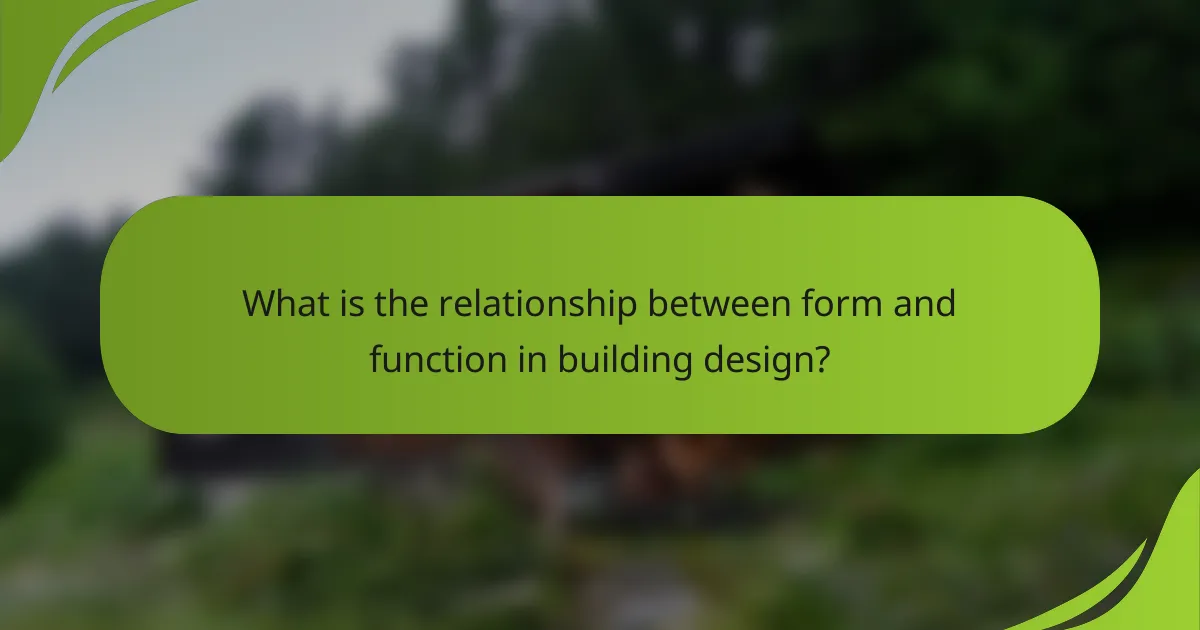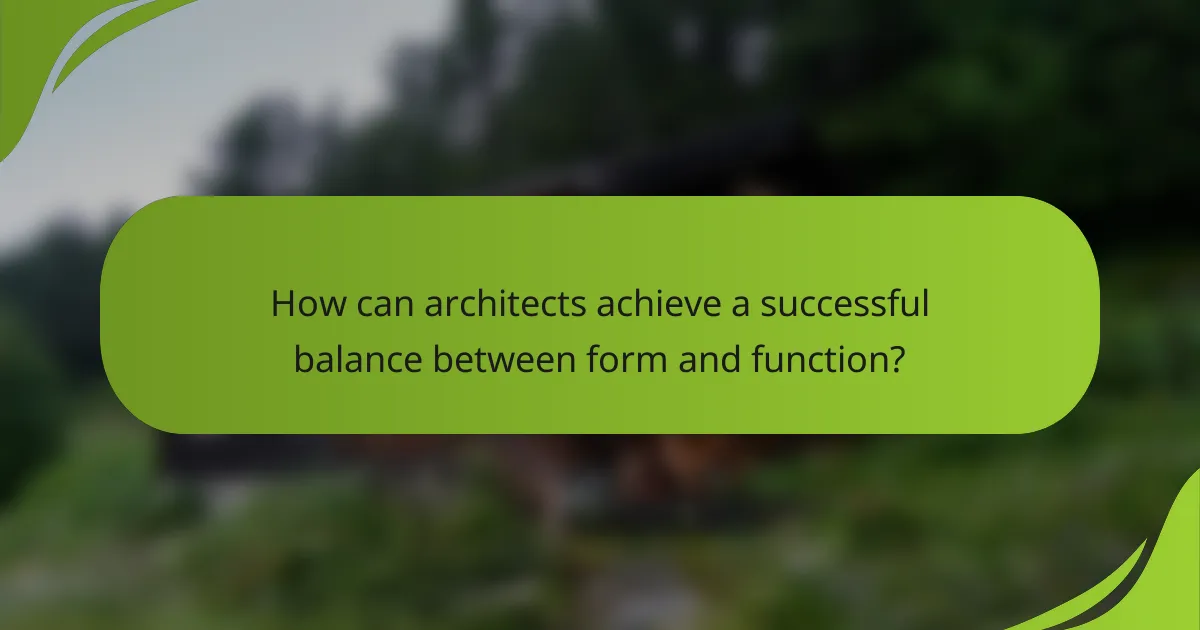The article explores the integral relationship between form and function in building design, where “form” refers to a building’s aesthetic and physical characteristics, and “function” relates to its purpose and usability. Effective architectural design harmonizes these elements, ensuring that the visual appeal enhances practical use. Key principles discussed include efficiency, aesthetics, and context, which guide architects in creating structures that serve their intended purposes while resonating with their environments. Historical examples, like the Guggenheim Museum, illustrate how thoughtful design can optimize user experience. Additionally, the article emphasizes the role of sustainable practices in merging form and function, demonstrating that well-designed buildings can improve occupant satisfaction and efficiency.

What is the relationship between form and function in building design?
The relationship between form and function in building design is integral and interdependent. Form refers to the aesthetic and physical appearance of a building. Function pertains to the building’s purpose and usability. Effective design harmonizes these two elements.
A building’s form can enhance its function by improving usability. For example, open floor plans facilitate movement and interaction. Conversely, function can dictate form; a gymnasium requires high ceilings for activities.
Architectural principles often emphasize this relationship. The Bauhaus movement highlighted that form should follow function. This philosophy remains influential in contemporary architecture.
Moreover, sustainable design practices merge form and function. Energy-efficient buildings often feature designs that optimize natural light and ventilation. These designs demonstrate that aesthetic considerations can complement functional needs.
In summary, the relationship between form and function is essential for creating effective and meaningful architecture.
How do architects define form and function in their designs?
Architects define form as the physical shape and appearance of a building. They consider aesthetics, proportions, and materials in this aspect. Function refers to how the building serves its intended purpose. This includes usability, accessibility, and efficiency. Architects analyze both elements to create harmonious designs. Historical context shows that famous architects like Louis Kahn emphasized the interplay between form and function. His work illustrates that a well-designed building enhances user experience. Thus, architects strive for a balance that meets both visual and practical needs.
What are the historical perspectives on form and function in architecture?
Historical perspectives on form and function in architecture reveal a complex evolution. In ancient times, structures emphasized functionality, like the Parthenon, which served religious purposes. The Renaissance shifted focus to aesthetics, blending beauty with utility. The Industrial Revolution introduced new materials, allowing for innovative designs that prioritized function. Modernist architects, like Le Corbusier, advocated for form following function, emphasizing simplicity and practicality. Postmodernism reacted against this, reintroducing ornamentation and historical references. Each era reflects a balance between form and function, shaped by cultural and technological advancements.
How do cultural influences shape the understanding of form and function?
Cultural influences shape the understanding of form and function by dictating aesthetic preferences and practical needs. Different cultures prioritize various elements in design based on their historical, social, and environmental contexts. For example, traditional Japanese architecture emphasizes simplicity and harmony with nature, influencing both form and function. In contrast, Western architecture often showcases grandeur and complexity, reflecting different cultural values. Studies show that cultural background affects how people perceive space and utility. This is evident in how residential designs vary globally, with some cultures favoring open spaces for communal living while others prioritize privacy. Thus, cultural influences are crucial in determining how form and function are interpreted and executed in building design.
Why is the balance between form and function important in building design?
The balance between form and function is crucial in building design because it ensures both aesthetic appeal and practical usability. A well-designed building must attract users while serving its intended purpose effectively. Aesthetic elements can enhance user experience and community engagement. Conversely, functional elements ensure safety, accessibility, and comfort. The American Institute of Architects emphasizes that successful buildings integrate both aspects to create environments that are both beautiful and useful. Historical examples, such as the Sydney Opera House, showcase how form can inspire while still meeting operational needs. Ultimately, achieving this balance leads to sustainable and enduring architectural solutions.
What are the consequences of prioritizing form over function?
Prioritizing form over function can lead to several negative consequences. Buildings may become aesthetically pleasing but lack practicality. This can result in inefficient use of space. Users may experience discomfort due to poor design choices. Maintenance costs can increase if materials are not durable. Safety hazards may arise from neglecting functional requirements. For example, inadequate exits can pose risks in emergencies. Overall, focusing solely on form can compromise usability and long-term value.
How does functionality enhance the aesthetic appeal of a building?
Functionality enhances the aesthetic appeal of a building by integrating practical design elements with visual harmony. When a building serves its intended purpose effectively, it often leads to a more thoughtful and appealing design. For example, well-placed windows provide natural light while contributing to the overall facade. This balance creates a visually pleasing structure that feels inviting. Additionally, functional spaces can lead to innovative architectural forms that enhance the building’s character. Historical examples show that buildings designed with purpose often become iconic due to their unique aesthetics. The Sydney Opera House exemplifies this, where its functional design contributes to its striking appearance. Thus, functionality and aesthetics are interconnected, leading to buildings that are both useful and beautiful.

What are the key principles that govern the relationship between form and function?
The key principles that govern the relationship between form and function include efficiency, aesthetics, and context. Efficiency refers to how well a building’s design supports its intended use. Aesthetics involves creating visually appealing structures that enhance user experience. Context emphasizes the importance of integrating buildings within their environment.
These principles ensure that a building not only serves its purpose but also resonates with its surroundings. For instance, a well-designed library should facilitate quiet study while also being inviting. Historical examples, such as the Guggenheim Museum by Frank Lloyd Wright, illustrate this relationship effectively. The building’s spiral form enhances visitor flow while providing a unique visual experience.
How do different architectural styles approach form and function?
Different architectural styles approach form and function in unique ways. Modern architecture emphasizes minimalism and open spaces, prioritizing functionality. It often uses materials like glass and steel to create structures that appear light and airy. In contrast, Gothic architecture focuses on verticality and intricate details, with pointed arches that enhance both aesthetic appeal and structural integrity.
Classical architecture, rooted in symmetry and proportion, balances form and function through harmonious designs, like columns and pediments. Meanwhile, Brutalism showcases raw concrete and bold shapes, emphasizing functionality over ornamentation. Each style reflects cultural values and technological advancements of its time, shaping how buildings serve their intended purposes.
For example, the Bauhaus movement integrated art and technology, resulting in functional designs that also valued aesthetics. Ultimately, the approach to form and function varies significantly across styles, influenced by historical context and design philosophy.
What role does sustainability play in the form-function relationship?
Sustainability significantly influences the form-function relationship in building design. It dictates how structures are shaped to minimize environmental impact while fulfilling their intended purpose. Sustainable design often leads to innovative forms that enhance energy efficiency, such as passive solar orientation and natural ventilation systems. These forms are not only aesthetically pleasing but also functional in reducing energy consumption. Research indicates that buildings designed with sustainability in mind can achieve up to 50% energy savings compared to conventional designs. This integration of sustainability into form and function results in structures that are both environmentally responsible and effective in serving their occupants’ needs.
How does user experience influence the design of form and function?
User experience significantly influences the design of form and function in building design. It shapes how users interact with a space. Designers prioritize usability to enhance comfort and accessibility. Effective layouts facilitate movement and engagement. Aesthetic elements also contribute to emotional responses. Research indicates that spaces designed with user feedback lead to higher satisfaction. For instance, studies show that well-designed environments improve productivity and well-being. Therefore, user experience directly informs both the physical layout and aesthetic choices in building design.
What examples illustrate the effective integration of form and function?
The Sydney Opera House exemplifies the effective integration of form and function. Its unique sail-like design enhances its aesthetic appeal while serving as a performance venue. The building’s acoustics are optimized for sound quality, showcasing functionality. Another example is the Guggenheim Museum in Bilbao. Its organic shapes create visual interest and facilitate the flow of visitors. The design allows natural light to illuminate the interior, enhancing the visitor experience. Additionally, the High Line in New York City integrates green space within an urban environment. Its elevated park design provides recreational space while preserving historical rail infrastructure. These examples demonstrate that thoughtful design can harmonize visual appeal with practical use.
Which famous buildings exemplify the harmony of form and function?
The Sydney Opera House exemplifies the harmony of form and function. Its unique sail-like design enhances its aesthetic appeal while serving as a concert hall and theater. The Guggenheim Museum in New York City also showcases this balance. Its spiral structure allows for natural light and an uninterrupted flow of exhibits. The Villa Savoye in France is another example. Designed by Le Corbusier, it integrates functionality with modernist aesthetics. Each of these buildings demonstrates how architectural design can effectively blend visual beauty with practical use.
How do modern technologies impact the form-function relationship in architecture?
Modern technologies significantly enhance the form-function relationship in architecture. They allow for innovative designs that prioritize both aesthetics and usability. Advanced software enables architects to visualize complex structures before construction. Building Information Modeling (BIM) facilitates precise planning and integration of systems. Smart materials adapt to environmental conditions, improving functionality. Technologies like 3D printing enable unique shapes that traditional methods cannot achieve. Sustainable technologies enhance energy efficiency, aligning form with ecological function. The integration of automation in buildings improves user experience and operational efficiency. These advancements demonstrate a clear synergy between form and function in contemporary architectural practice.

How can architects achieve a successful balance between form and function?
Architects can achieve a successful balance between form and function by integrating aesthetic appeal with practical usability. They should prioritize user needs in the design process. This involves understanding how spaces will be used and who will use them. Architects can utilize design principles such as symmetry, proportion, and scale to enhance visual appeal. They also need to consider materials and construction methods that support both durability and design. Employing sustainable practices can further enhance functionality while maintaining beauty. Research shows that well-designed buildings improve user satisfaction and efficiency. For example, the study “The Impact of Building Design on Occupant Well-Being” by Zimring and Joseph highlights the correlation between design quality and user experience. This underscores the importance of a thoughtful approach to balancing both aspects in architectural design.
What strategies can be employed to enhance the relationship between form and function?
Integrating form and function in building design can be enhanced through several strategies. First, prioritize user needs during the design process. This ensures that functionality aligns with the intended use of the space. Second, employ iterative design methods. Prototyping and testing can reveal how design choices affect usability.
Third, utilize sustainable materials. These often offer both aesthetic appeal and practical benefits, such as energy efficiency. Fourth, incorporate flexible spaces. Adaptable areas can serve multiple purposes, enhancing functionality without compromising form.
Fifth, focus on natural light and ventilation. These elements can improve both the comfort and aesthetic quality of a space. Lastly, engage in multidisciplinary collaboration. Input from architects, engineers, and users can create a cohesive design that balances form and function effectively.
How can collaboration between designers and engineers improve outcomes?
Collaboration between designers and engineers can significantly improve outcomes by integrating creative and technical perspectives. Designers focus on aesthetics and user experience, while engineers prioritize functionality and safety. This partnership fosters innovative solutions that balance form and function effectively. Research indicates that projects with cross-disciplinary collaboration often achieve higher satisfaction rates. For instance, a study by the National Institute of Standards and Technology found that collaborative teams reduce project costs by up to 30%. Enhanced communication between these roles leads to fewer misunderstandings and rework. Overall, their collaboration streamlines the design process and enhances the final product’s quality.
What role does client feedback play in achieving form-function balance?
Client feedback is crucial in achieving form-function balance in building design. It provides insights into user needs and preferences. This feedback helps designers align aesthetic appeal with practical usability. Understanding client perspectives allows for adjustments that enhance functionality without compromising design. Research shows that projects incorporating client input often result in higher satisfaction rates. For instance, a study by the American Institute of Architects found that client involvement directly correlates with project success. Therefore, leveraging client feedback is essential for optimizing both form and function in architectural projects.
What common challenges do architects face in balancing form and function?
Architects commonly face challenges in balancing form and function. One challenge is meeting aesthetic demands while ensuring usability. Another issue is adhering to budget constraints without compromising design integrity. Architects also struggle with site limitations that affect both visual appeal and practical use. Additionally, they must consider sustainability, which can complicate design choices. The integration of technology in buildings presents further challenges in maintaining harmony between form and function. Lastly, client expectations can often conflict with practical design solutions, creating tension in the architectural process.
How can budget constraints affect design decisions regarding form and function?
Budget constraints significantly influence design decisions regarding form and function. Limited financial resources often lead to compromises in materials and construction techniques. Designers may prioritize essential functional elements over aesthetic considerations due to cost. This can result in simpler forms that fulfill basic needs rather than elaborate designs. Additionally, budget limitations can restrict the use of innovative technologies that enhance functionality. Historical examples show that iconic buildings sometimes emerge from financial constraints, leading to unique solutions. The Sydney Opera House faced budget issues that shaped its final design. Ultimately, budget constraints can drive creativity in finding cost-effective solutions while balancing form and function.
What are the implications of regulatory requirements on form-function harmony?
Regulatory requirements significantly influence form-function harmony in building design. These regulations ensure that structures meet safety, accessibility, and environmental standards. Compliance often dictates specific design elements, impacting aesthetic choices and functional layouts. For example, building codes may require certain materials or structural supports, which can alter the intended visual appeal. Additionally, zoning laws may restrict height and bulk, affecting how a building integrates with its surroundings.
The Americans with Disabilities Act (ADA) mandates accessibility features, which can shape the internal arrangement of spaces. Studies show that buildings designed within regulatory frameworks often achieve a balance between form and function. A report by the National Institute of Building Sciences highlights that adherence to codes can lead to innovative design solutions that enhance both usability and visual integrity. Therefore, regulatory requirements play a crucial role in guiding the relationship between form and function in architecture.
What best practices can ensure a successful relationship between form and function in building design?
To ensure a successful relationship between form and function in building design, prioritize user needs and site context. Understanding the specific requirements of occupants is essential. This includes assessing how spaces will be utilized. Conducting thorough site analysis helps integrate the building with its environment. Sustainable design practices enhance functionality while maintaining aesthetic appeal. Utilizing flexible spaces accommodates varying needs over time. Engaging in iterative design processes fosters collaboration among architects, engineers, and stakeholders. Research shows that buildings designed with both form and function in mind improve user satisfaction and performance. For example, a study by the American Institute of Architects found that well-designed spaces can increase productivity by up to 20%.
How can ongoing education and research improve architectural practices?
Ongoing education and research enhance architectural practices by integrating new knowledge and techniques. Architects who pursue continuous learning stay updated with industry trends. This adaptability leads to innovative design solutions. Research provides evidence-based insights into sustainable materials and construction methods. For instance, studies show that energy-efficient designs reduce operational costs by up to 30%. Furthermore, ongoing education fosters collaboration among professionals. This exchange of ideas contributes to improved project outcomes. Regular training also ensures compliance with evolving building codes and standards. Ultimately, these practices elevate the overall quality of architectural work.
What tools and technologies can assist architects in optimizing form and function?
Architects can utilize various tools and technologies to optimize form and function in their designs. Building Information Modeling (BIM) software allows for detailed visualization and simulation of architectural plans. Tools like AutoCAD and Revit enable precise drafting and modeling. Parametric design software, such as Grasshopper, helps in creating complex geometries that enhance functionality. Energy analysis tools assess a building’s performance regarding energy efficiency. Virtual Reality (VR) and Augmented Reality (AR) technologies provide immersive experiences for design evaluation. Additionally, 3D printing allows architects to create physical models for better understanding of spatial relationships. These technologies collectively enhance design accuracy, efficiency, and innovation in architectural projects.
The primary entity of this article is the relationship between form and function in building design. The article explores how architectural design integrates aesthetic appeal (form) with practical usability (function), emphasizing their interdependence. Key discussions include historical perspectives, cultural influences, and the impact of sustainability on design. It also addresses the challenges architects face in achieving this balance, the role of user experience, and the importance of collaboration in optimizing building outcomes. Ultimately, the article highlights best practices and modern technologies that enhance the harmony between form and function in architecture.